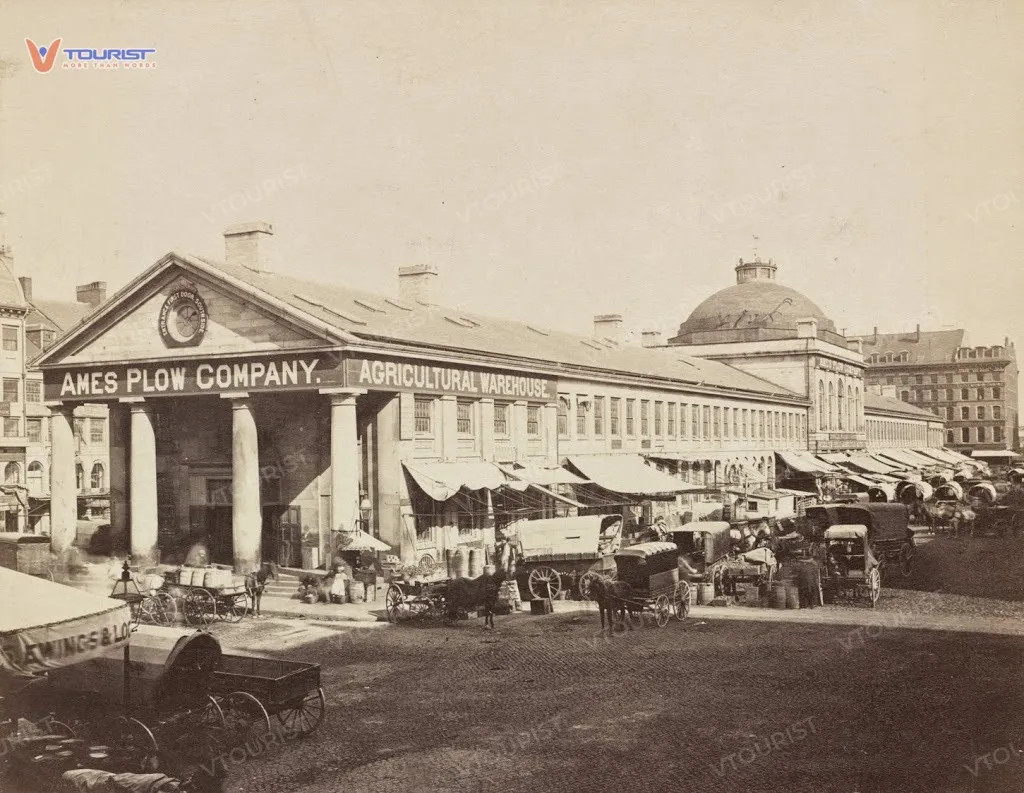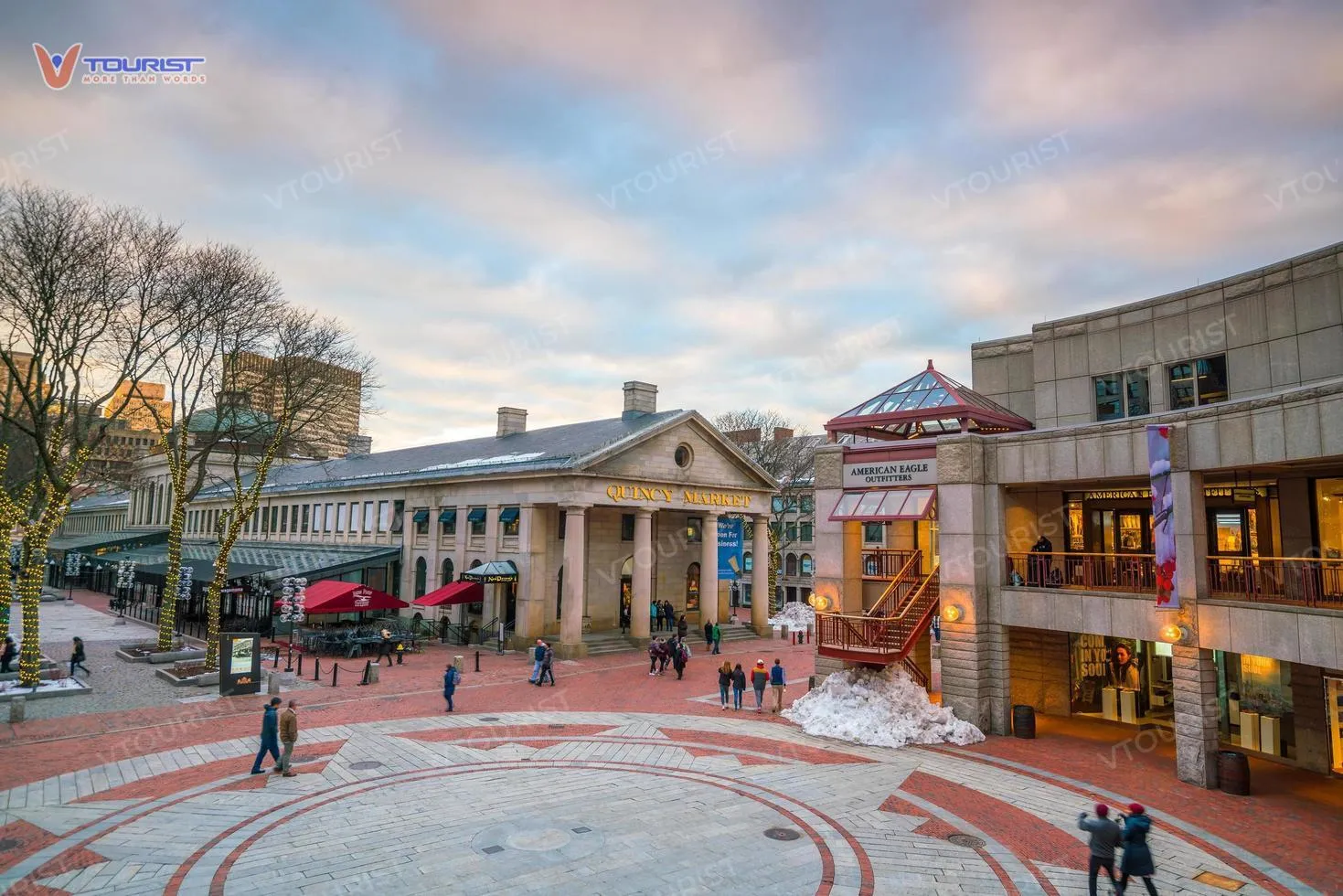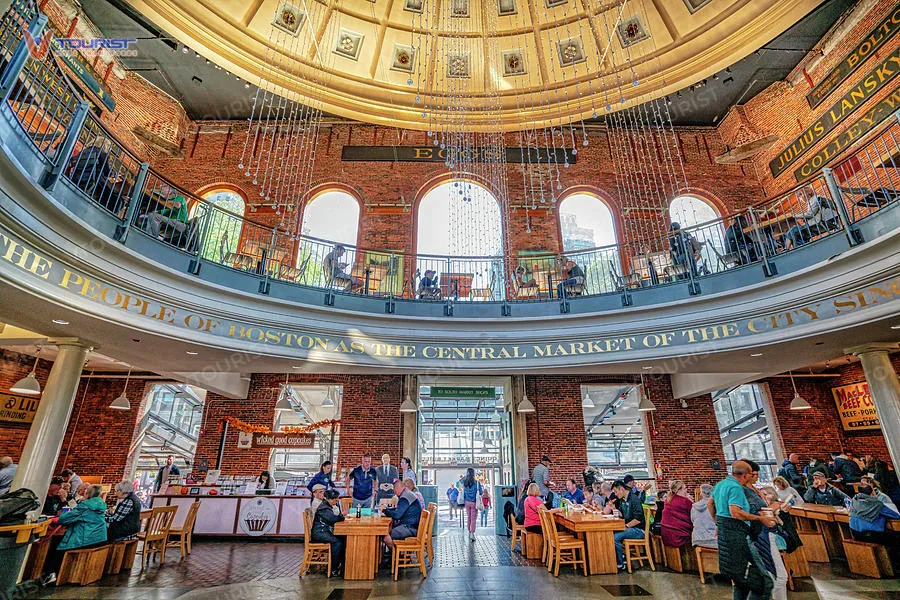Massachusetts, a state renowned for its rich history and culture in the United States, attracts visitors not only with its ancient architecture and famous museums but also with the vibrancy and uniqueness of its local markets. In the heart of bustling Boston, Quincy Market stands as a long-standing commercial symbol, a must-visit destination to experience the rhythm of life and explore the unique local culture.
Let’s explore Quincy Market, one of the most attractive and bustling local markets in Massachusetts, with “Du lịch khắp thế gian” in the article below.
Quincy Market – Boston’s Gem
Prime Location and Long History
Located right in the center of Boston, Massachusetts, Quincy Market proudly stands as one of the city’s oldest and busiest markets. Adjacent to the famous Faneuil Hall, Quincy Market is not just a market; it’s also part of the Faneuil Hall Marketplace National Historic Landmark, witnessing Boston’s ups and downs over nearly two centuries.
Quincy Market was built in 1826, amidst Boston’s strong economic and commercial development. The Faneuil Hall area had been a bustling trading center before, but it gradually became overloaded, unable to meet the increasing trade demand. Therefore, the city government decided to build a new market, and Quincy Market was born to solve this problem.

The talented architect Alexander Parris, famous for his neoclassical design style, was entrusted with designing Quincy Market. He chose a location east of Faneuil Hall, near Boston’s bustling harbor area at the time, to build the new market. To create enough space for the Quincy Market project, part of the harbor area was reclaimed from the sea, a significant milestone in Boston’s urban expansion and development. The emergence of Quincy Market not only expanded the commercial space but also contributed to the renovation and reconstruction of six surrounding streets, creating a spacious and modern city center area.
From its early days, Quincy Market has affirmed its role as a leading shopping center for agricultural products and food. The market stalls sell a variety of essential goods, from eggs, milk, cheese to fresh bread, creating a vibrant and colorful shopping space. A fascinating discovery during the market’s expansion in the late 1970s revealed evidence of on-site livestock slaughtering, demonstrating Quincy Market’s important role in providing fresh food for Boston residents for decades.
The bustling atmosphere of Quincy Market extends beyond the main building to the surrounding area. Street vendors gather in the squares and along the walls, creating a lively and vibrant picture of a bustling local market.
Unique Architecture – A Blend of Classic and Modern

The main building of Quincy Market is a massive architectural work, 163 meters long and covering an area of 2,500 square meters. It is a prime example of the large-scale use of granite and glass in 19th-century architecture. Built mainly of granite, Quincy Market showcases a delicate combination of classical and modern architectural styles, bringing a majestic yet elegant beauty.
The east and west facades of the market are designed in a classical Roman style, with solid triangular pediments and dignified Doric columns. These details not only create a solemn, ancient look but also express sophistication and connection to traditional architectural values. In contrast, the sides of the building are more modern, with rows of vertical rectangular windows, creating an interesting and harmonious contrast with the classical facade.

The interior of Quincy Market is intelligently designed with a system of cast iron columns and iron tie rods, creating a spacious, airy space filled with natural light. On the roof, eight chimneys are evenly arranged, along with a prominent copper dome in the center, creating a unique architectural highlight for the entire structure. This dome not only has aesthetic value but also shelters the common seating area and the main entrances on both sides, enhancing the convenience and attractiveness of the market.
Quincy Market also includes two auxiliary buildings, North Market and South Market, built of brick and granite, each building having one and a half stories. Despite undergoing several renovations compared to the main building, these two buildings still retain their distinctive architecture and are being considered for recognition as Boston Historic Landmarks, contributing to the preservation of the market’s valuable architectural heritage.
The entire Quincy Market complex was listed on the National Register of Historic Places in 1966 and officially recognized as a Boston Historic Landmark in 1996. The unique architecture of Quincy Market not only reflects Boston’s development through the ages but is also an indispensable part of the city’s cultural and historical heritage.
Shopping and Culinary Paradise
Quincy Market Boston is not only an attractive tourist destination for its ancient architecture but also a shopping and culinary paradise where visitors can find countless unique items characteristic of Massachusetts and enjoy diverse culinary flavors from around the world.
Stepping into Quincy Market, visitors will be overwhelmed by the diversity of goods sold in the two main markets, North Market and South Market. From souvenirs, jewelry, clothing, leather goods to handicrafts and paintings, Quincy Market meets all shopping needs of visitors. In particular, handmade souvenirs made of wood, glass, and leather, bearing the style of Boston and New England, are always the top choice for tourists to bring back as gifts for relatives and friends. Exquisite jewelry, unique artworks, and durable leather goods are also interesting shopping suggestions at Quincy Market.

Not only a shopping paradise, Quincy Market is also an attractive culinary destination with countless options from local specialties to international cuisine. Visitors can easily find dishes from many different cultures such as Thai, Indian, Chinese, Italian, and American. In particular, Clam Chowder, Boston’s signature creamy clam soup, is a must-try dish when visiting Quincy Market. With fresh ingredients and unique recipes, Clam Chowder at Quincy Market offers a special, unforgettable flavor.

In addition, visitors can also enjoy many other attractive dishes such as lobster rolls, Italian-style pizza, pasta, Asian dishes, and many delicious desserts. The restaurants and eateries at Quincy Market not only serve diverse cuisine but also offer a cozy and friendly atmosphere, creating a memorable culinary experience for visitors.
Explore the Unique Features of Other Local Markets in Massachusetts
Massachusetts not only has the famous Quincy Market but also boasts many other attractive and bustling local markets, each market bearing its own unique characteristics, reflecting the culture and products of each region. From fresh produce markets where local farmers directly sell their products to unique handicraft markets where artisans showcase their creative works, the local markets in Massachusetts are all interesting destinations for visitors to explore and experience.
Farmers markets are often held on weekends, bringing a lively and joyful atmosphere of a country market. Visitors can find here all kinds of fresh seasonal fruits and vegetables, pure honey, dairy products, meat and poultry, and many other local specialties. Shopping at farmers markets not only helps visitors enjoy fresh, quality food but also supports local farmers and explores the unique culinary culture of Massachusetts.
In addition, handicraft markets are also a unique feature of Massachusetts. Here, visitors can admire and shop for unique handcrafted products made by talented artisans. From ceramics, leather goods, wooden items, jewelry, clothing to artworks such as paintings and sculptures, each product bears a unique mark, reflecting the creativity and dedication of the artisan. Visiting handicraft markets is a great opportunity for visitors to discover and appreciate the traditional cultural values and artistic talents of the people of Massachusetts.
Tips for Visiting Quincy Market
To have a complete and memorable visit to Quincy Market, “Du lịch khắp thế gian” would like to offer you some helpful tips:
- Ideal time: Quincy Market is open daily, but the best time to visit is on weekends or holidays when the market becomes most vibrant and bustling.
- Transportation: Quincy Market is located in downtown Boston, very easy to get to by public transport such as subway, bus, or taxi. If you want to experience the Boston atmosphere, walking to the market is also a fun option.
- Shopping and dining: Take your time to explore all the stalls and enjoy the diverse cuisine at the market. Don’t forget to try the famous Clam Chowder and shop for unique souvenirs.
- Explore the surrounding area: Quincy Market is located in the Faneuil Hall Marketplace area, which has many other attractions such as Faneuil Hall, North Market, South Market, and historic neighborhoods. Take time to explore this area for a comprehensive view of Boston.
- Prepare cash: Although many stores at Quincy Market accept card payments, it is still advisable to bring some cash for convenient transactions at small stalls or buying street snacks.
Conclusion
Quincy Market is not only an attractive and bustling local market in Massachusetts but also a cultural and historical symbol of Boston. With its unique architecture, diverse shopping and dining space, and prime location in the city center, Quincy Market is a must-visit destination on your journey to explore Massachusetts. Come to Quincy Market to feel the vibrant rhythm of life, explore the unique local culture, and enjoy wonderful shopping and culinary experiences. Surely, a visit to Quincy Market will leave you with unforgettable impressions of one of the most attractive local markets in the United States.